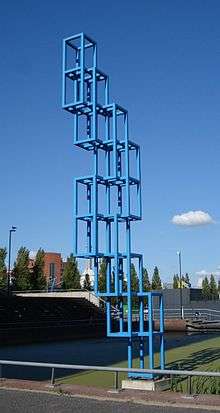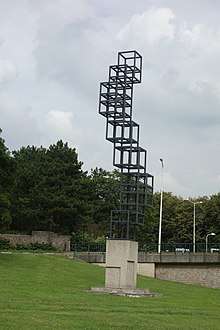Joost Baljeu
Joost Baljeu (1 November 1925 – 1 July 1991) was a Dutch painter, sculptor and writer. He is known for his large outdoor painted steel structures.
Joost Baljeu | |
|---|---|
 | |
| Born | 2 November 1925 Middelburg, Netherlands |
| Died | 1 July 1991 (aged 65) Amsterdam, Netherlands |
| Nationality | Dutch |
| Occupation | Artist |
| Known for | Steel structures |
Life
Joost Baljeu was born in Middelburg on 1 November 1925. During World War II (1939–45) he began painting in an expressionist, realistic and semi-abstract idiom. After Cubism he evolved to constructivism. He made his first reliefs in 1954-55. From 1957 to 1972 he was a professor at the Royal Academy of Art, The Hague in the Hague.[1] The Canadian artist Eli Bornstein began to make three-dimensional "structurist" reliefs during a sabbatical in Italy and the Netherlands in 1957.[2] He met and was influenced by artists such as Jean Gorin, Joost Baljeu, Anthony Hill, Kenneth Martin, Mary Martin, Victor Pasmore and Georges Vantongerloo.[3]
In 1958-59 Baljeu was a guest lecturer at the University of Saskatchewan in Canada. In 1966 he was visiting professor at the Minneapolis School of Art in the US. He died on 1 July 1991 in Amsterdam.[1]
Work

Exhibitions
- 1965 Zonnehof, Amersfoort
- 1975/1976 Gemeentemuseum, The Hague
- 1979 Kröller-Müller Museum, Otterlo
- 1991 Stedelijk Museum, Amsterdam
- 2000 Steel in Picture (group) in Old Slot Heemstede: F19 (model 1986/87)
Museums
- The Mondriaan House in Amersfoort
- Kröller-Müller Museum in Otterlo. Two works are part of the museum:
- Synthetic Construction F5-2 CD (1966/68) and
- Synthetic Construction F15 No. 1. (1983/87),
- The Sculpture F26 1990 was donated to the museum in 1991 by Baljeu's widow.
Public spaces

- Lightning (1955), Wijkcentrum Open Vaart, Meidoornplein in Amsterdam-Noord
- Synthetic construction F8-1B (1978), Plesmanweg, The Hague
- Wall sculpture (1980), police Burg. Wegstapel Square in Zoetermeer (architectural design of colored plexiglass panels in a two-story aluminum construction)
- Synthetic construction F11 (1981), courtyard Vest in Dordrecht - reinstated in 1999
- Synthetic construction F13 (1984), Avenue of the United Nations in Dordrecht - reinstated in 1999
- F26 (1990) in the sculpture park of the Kröller-Müller Museum in Otterlo
- Spacetime (I) (1989) in Rotterdam, Prince Alexander district
- Spacetime II (restored in 2004) n Rotterdam, Prince Alexander
Publications
- In 1958 Baljeu published Mondrian and Miró (published by Edition de Beek in Amsterdam)
- From 1958 to 1964 he was responsible for the international journal Structure, a stage for the geometric abstract art.
- From 1958 to 1962 he worked on the monograph Theo van Doesburg (published by Vista, London in 1974).
References
Citations
| Wikimedia Commons has media related to Joost Baljeu. |
Sources
- "Biografie Joost Baljeu". Galerie Witteveen. Retrieved 2014-08-14.
- Ivanochko, Bob (2014). "BORNSTEIN, ELI (1922–)". Encyclopedia of Saskatchewan. University of Regina. Archived from the original on 2014-08-09. Retrieved 2014-08-09.CS1 maint: ref=harv (link)
- Moppet, George (2008-05-21). "Eli Bornstein". Canadian Encyclopedia. Historica Canada. Retrieved 2014-08-09.CS1 maint: ref=harv (link)